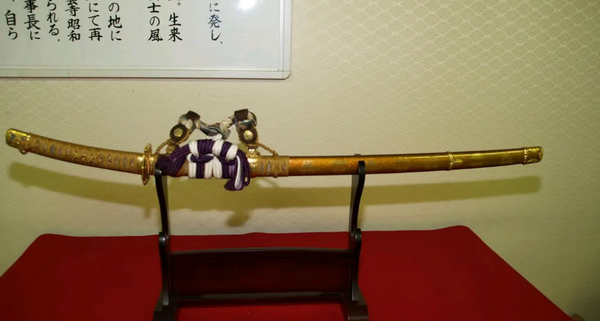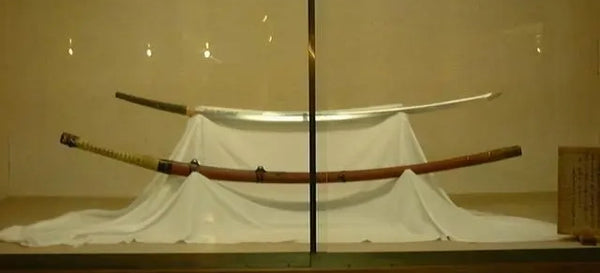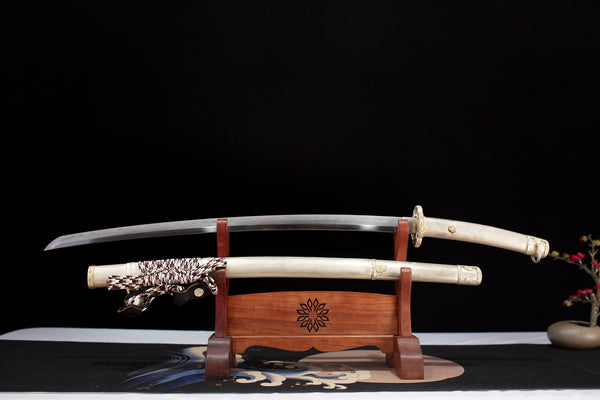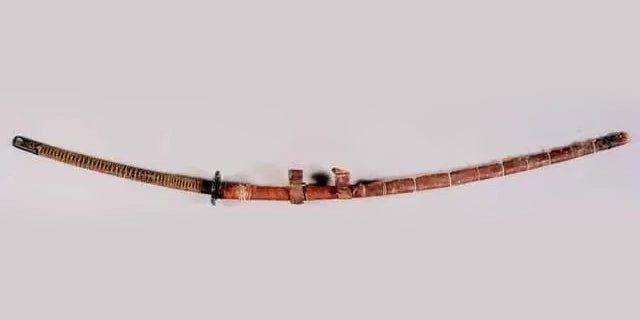Tachi-Killing Blade Used by Cavalry

Over the course of its long history, the Japanese sword has improved and evolved in terms of usage, shape, craftsmanship, and decoration, developing a variety of different forms of Japanese swords that have played a role as weapons at different times in history. Among them, the tachi is considered by many to be the representative of the Japanese sword because of its special place in ancient Japanese history and its beautiful shape.

Tachi meaning
The tachi is one of the categories of Japanese swords, a type from the early stages of Japanese sword development, generally longer and used for cavalry combat or command. The blade is more curved and the hilt is mostly upturned.
The character "Ta" is commonly used as a large character in ancient Chinese, so "Tachi" can also be understood as "big sword". The Japanese pronunciation of Tachi, "たち", is generally believed to come from the homophonic meaning of "cut off" in Japanese. In countless movies, literature, and popular electronic games, the appearance of tachi often means that the creators want to integrate bushido culture into their works. Thus, even in modern society, where cold weapons have been abandoned, Tachi itself has been entrusted with many cultures, spirits, and emotions.

Tachi type and length
Tachi
The most common type of tachi is the one with a blade of 60 centimeters or more and 90 centimeters or less.
Kenukigata tachi

Kenukigata tachi appeared in the middle of the Heian period and refers to the frequent use of it in battles by court forces. Named for its shape, which resembles the ancient Japanese hair-puller (tweezers), the Kenukigata tachi is a narrow blade shape with a thin blade that curves considerably at the beginning of the handle, and a hira-zukuri construction, with a length of generally around 90 centimeters.
Itomaki no tachi

The tachi, which emphasized practicality and had both the handle and the saya tied with a set of buttons and leather buttons, appeared in the Kamakura period and was later developed into the jindachi.
Jindachi

Developed from Itomaki no tachi, which emphasized decorative tachi, it was a sword that was worn with the formal attire of martial artists in the Edo period.
Nodachi

This refers to a tachi with a blade length of 90 centimeters or more, but less than 150 centimeters.
Kodachi

The blade is less than 60 centimeters of tachi, but because the shape is closer to a straight line than katana and different from wakizashi, it usually has the length of a large wakizashi.
Odachi

3.7 meter long Norimitsu odachi, It is also the longest sword in Japan.
The term refers to tachi with a blade length of 150 centimeters or more, and large odachi longer than three feet also exist.The emergence of Nodachi is undoubtedly a pinnacle of Tachi's development, but although Nodachi has astonishing power, its weight and inertia are also terrifying. Due to the pursuit of ultimate length, samurai must carry Nodachi to the battlefield, rather than wearing it at the waist like an ordinary Tachi. The process of extracting and retracting knives is also very troublesome, and unique methods must be used, such as rib extraction, herringbone insertion, and other genres of techniques to complete.
The distinction by length is mostly used in textbooks to make it easier for beginners to learn, but there are more detailed distinctions in specialized fields of study. In addition to the above, there is also heijo no tachi, hirazaya no tachi, hosodachi, hyogo-gusari no tachi, ikamono-stukuri no tachi, etc., as well as hadachi, which is half katana and half tachi.
What is the tachi used for?
The tachi originated in Japan during the Heian period, when the Japanese sword became increasingly curved from the early Warabiteto in order to accommodate horseback combat on the battlefield. The Kenukigata tachi used by samurai generals in the early Heian period retained the characteristics of the Warabiteto in its curvature and was a tachi that could be used with one hand.
In the Genpei Battle of the late Heian Period, samurai wielding tachi of incredible length were able to take advantage of the weight, length, and inertia of the weapon on their horses in the "one-horse race" between the generals. The samurai's fame on the battlefield made them realize that "an inch long is an inch strong," and although the odachi was too heavy to be used by anyone, ordinary tachi began to increase in length under their influence. At the end of the Heian period, during the years of war, the status of the tachi not only increased because of its performance on the battlefield, but also because of the rise of the power of the martial arts family and the strengthening of the military and political system of the upper echelons of society, which made the tachi more and more of a symbol of the times. Not only did samurai warriors value their swords, but even the emperor was a fan of the tachi.
For this reason, most people consider the tachi to be the most valuable of all Japanese swords, as the principle of "circular linkage" is better utilized physically with the blade tilted slightly back than upright, in other words, the tachi is able to show the maximum range of cuts at various angles, making it more suitable for horseback riders. which is more suitable for horse riders. In addition, the length and weight of the tachi is superior to other types of Japanese swords, and the more force the wielder puts into it, the more it can be utilized to maximize its "freedom of movement and sharpness".
During the Kamakura period, the status of the samurai class was strengthened as never before, as they were given official positions to rule, were admired by the people and honored by their families, and were required to practice martial arts as well as literature, and to live and die for their loyalty and honor. The Tachi became the symbol of the samurai during this period, and the samurai sought the utility of the taijutsu, while at the same time viewing the appearance and image of the blade itself as a symbol of status.
The fact that the tachi sword has become world-renowned as "the first craft to reach the world's top level" is due in large part to the unique forging process that has been passed down from generation to generation. The selection of materials, temperature control, polishing techniques, and the timing of cooling are all based on the experience of swordsmiths accumulated over decades, and each swordsmith's tachi has its own unique characteristics and is different from the next, giving it the concept of a work of art.
In the Heian period, a large number of famous tachi were produced: doujigiri, mikadukimunechika, otenta odenta, jyuzumaru, and others were the masterpieces of Heian craftsmen, leaving behind national treasures for posterity, and during the Kamakura period, the culture of samurai swords was spreading across the country, and the tachi forging industry was also expanding in the Kamakura period, along with the samurai spirit. By the Kamakura period, samurai sword culture had spread throughout Japan along with the spirit of the samurai, and the tachi forging industry had reached its peak, with onimaru kunitsuna, Goro Nyudo,
Masamune, kikuichimonji norimune, and so on, being created during the Kamakura period.

The mikadukimunechika of the Five Great Swords.

Representative of Tachi in the Kamakura Era - Goro Nyudo Masamune
By the time of the Meiji Restoration, the privileges of the feudal samurai class had ended, and the tachi and other samurai swords went out with the samurai. Although there was a brief revival of the samurai sword at the end of the Shogunate period with the hustling and assassination campaigns, the strongest cold weapons were still tears in the eyes of the times in the face of firearms. With the abolition of the sword twice during the Meiji Restoration, the tachi, the once mighty killing blade of the battlefield, officially ended its historical mission and Japan began to move towards a new era.



Leave a comment
This site is protected by hCaptcha and the hCaptcha Privacy Policy and Terms of Service apply.